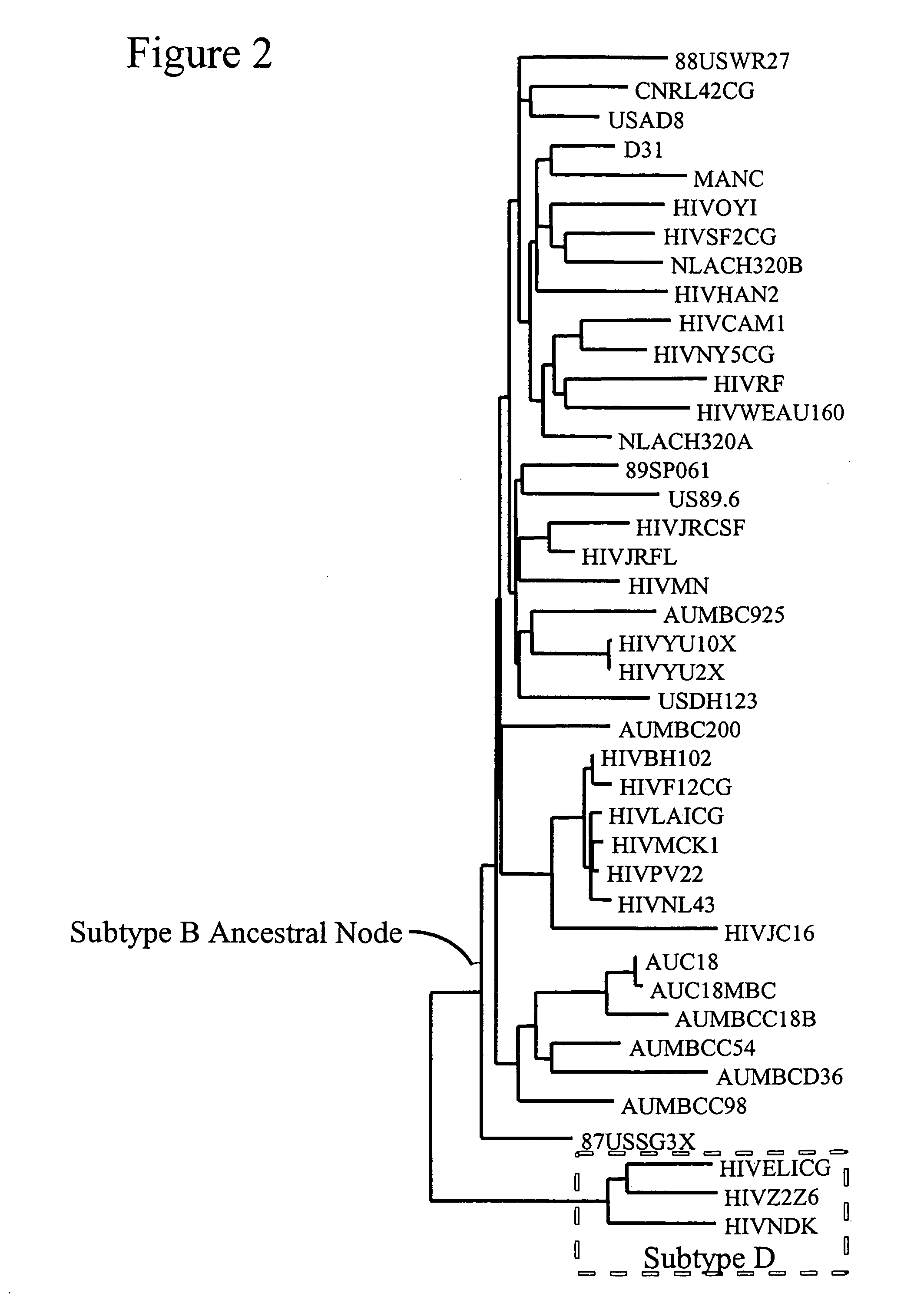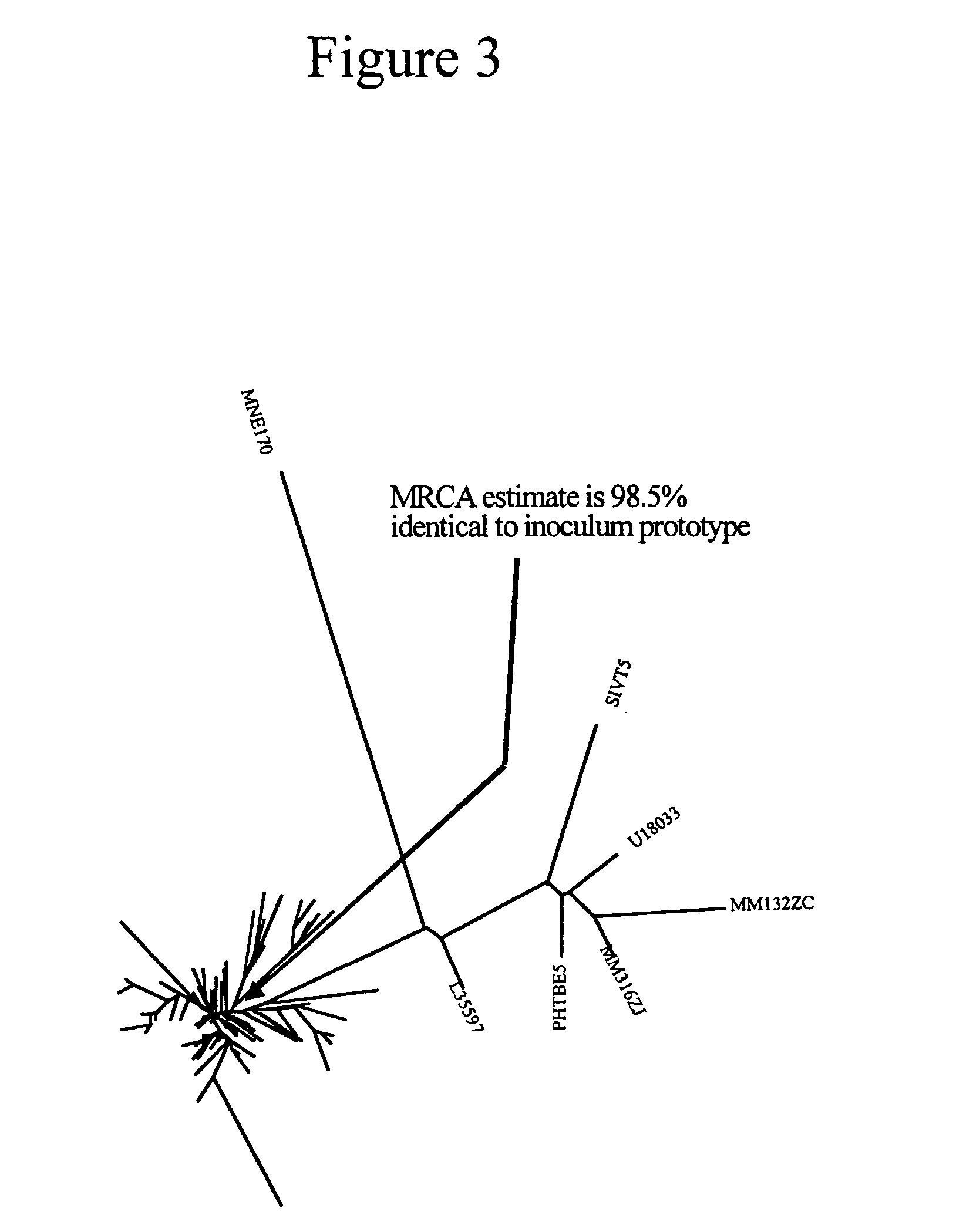Ancestral and COT viral sequences, proteins and immunogenic compositions
a technology of cot and cot viral sequences, applied in the field of cot viral sequences, proteins and immunogenic compositions, can solve the problems of hiv-1 being an extremely difficult target for vaccine development, not ideal immunogens, and hampered vaccine developmen
- Summary
- Abstract
- Description
- Claims
- Application Information
AI Technical Summary
Benefits of technology
Problems solved by technology
Method used
Image
Examples
example 1
Determination of Ancestral Viral Sequences
[0262]Sequences representing genes of a HIV-1 subtype C were selected from the GenBank and Los Alamos sequence databases. 39 subtype C sequences were used. 18 outgroup sequences (two from each of the other group M subtypes (FIG. 8) were used as an outgroup to root the subtype C sequences. The sequences were aligned using CLUSTALW (Thompson et al., Nucleic Acids Res. 22:4673-80 (1994)), the alignments were refined using GDE (Smith et al., CABIOS 10:671-5 (1994)), and amino acid sequences translated from them. Gaps were manipulated so that they were inserted between codons. This alignment (alignment I) was modified for phylogenetic analysis so that regions that could not be unambiguously aligned were removed (Learn et al., J. Virol. 70:5720-30 (1996)) resulting in alignment II.
[0263]An appropriate evolutionary model for phylogeny and ancestral state reconstructions for these sequences (alignment II) was selected using the Akaike Information Cr...
example 2
[0266]Different methods are available to determine the maximum likelihood phylogeny for a given subtype. One such method is based on the coalescent theory, which is a mathematical description of the genealogy of a sample of gene sequences drawn from a large evolving population. Coalescence analysis takes into account the HIV population in vivo and in the larger epidemic and offers a way of understanding how sampled genealogies behave when different processes operate on the HIV population. This theory can be used to determine the sequence of the ancestral viral sequence, such as a founder, or MRCA. Exponentially growing populations have decreasing coalescent intervals going back in time, while the converse is true for a declining population.
[0267]Epidemics in the USA and Thailand are growing exponentially. The coalescent dates for subtype B epidemics in the USA and Thailand are in accordance with the epidemiologic data. The coalescent date for subtype E epidemic in Thailand is earlie...
example 3
[0284]The conservation of HIV-1 subtype C CTL amino acid consensus epitopes was analyzed. The total number of epitopes was 395. The table below summarize the results of the similarly of each circulating viral sequence to the C subtype CTL consensus sequence. The determined ancestor viral sequence for the HIV-1 subtype C env protein (SEQ ID NO:4) has the highest score (98.48%). Note that the scores for several strains are below 65%, because truncated sequences were used.
[0285]
Sequence NameTotal AA numberPercentage CTL to ConsensuscCanc95-mod138998.48%cBR.92BR02537695.19%cBI.BU91071736391.90%cIN.2106836893.16%cIN.30190537093.67%cMW959.U0845335890.63%cBW.96BW121036592.41%cBI.BU91031636792.91%cZAM176.U8677835289.11%cMW965.U0845536492.15%cZAM174.16.U8676835188.86%c84ZR085.U8882232281.52%cSN.SE364A37093.67%cMW960.U0845436592.41%cBI.BU91081236893.16%cET.ETH222035890.63%cBI.BU91051836191.39%cIN.94IN1124636191.39%cBW.96BW15B0335990.89%cDJ.DJ259A35589.87%cBI.BU91021336592.41%cBW.96BW01B033629...
PUM
| Property | Measurement | Unit |
|---|---|---|
| Tm | aaaaa | aaaaa |
| temperature | aaaaa | aaaaa |
| pH | aaaaa | aaaaa |
Abstract
Description
Claims
Application Information
 Login to View More
Login to View More - R&D
- Intellectual Property
- Life Sciences
- Materials
- Tech Scout
- Unparalleled Data Quality
- Higher Quality Content
- 60% Fewer Hallucinations
Browse by: Latest US Patents, China's latest patents, Technical Efficacy Thesaurus, Application Domain, Technology Topic, Popular Technical Reports.
© 2025 PatSnap. All rights reserved.Legal|Privacy policy|Modern Slavery Act Transparency Statement|Sitemap|About US| Contact US: help@patsnap.com



